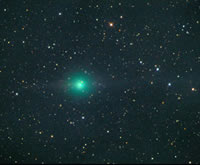International Space Station
-Now the 2nd Brightest Object in the Night Sky with final Solar Arrays Deployed

The International Space Station should now be the second brightest object in the night sky, following Friday's successful deploy of the S6 solar wings. Astronauts on board the ISS and space shuttle Discovery unfurled the arrays, successfully carrying out the main objective of the STS-119 mission. "Today was a great day," said ISS commander Mike Fincke to mission control Friday afternoon. "Today is the day the station went to full power." The length of the arrays unfurled Friday measures 73 meters (240 feet), tip to tip, with the S6 truss in between. The S6 solar array pair adds 2,926 square meters (9,600 square feet) to the station solar arrays, bringing the total surface area to nearly an acre.
read more at Universe Today
The Night Sky
-March

Astronomical attention at the start of the month is focused on Comet Lulin, making its first and likely last visit to the inner solar system. On the 28th the comet lies just to the northwest of the brightest star in the constellation of Leo, Regulus. It is currently brighter than predicted, on the edge of naked-eye visibility at magnitude 5.2, although you will need a very dark sky to stand any chance at all. It helps to have found the comet in binoculars first, and as with any faint and fuzzy astronomical object try to look out of the corner of your eye - the cells there are more sensitive to faint light than those in the centre.
read more from the Times Online
 The International Space Station should now be the second brightest object in the night sky, following Friday's successful deploy of the S6 solar wings. Astronauts on board the ISS and space shuttle Discovery unfurled the arrays, successfully carrying out the main objective of the STS-119 mission. "Today was a great day," said ISS commander Mike Fincke to mission control Friday afternoon. "Today is the day the station went to full power." The length of the arrays unfurled Friday measures 73 meters (240 feet), tip to tip, with the S6 truss in between. The S6 solar array pair adds 2,926 square meters (9,600 square feet) to the station solar arrays, bringing the total surface area to nearly an acre.
read more at Universe Today
The International Space Station should now be the second brightest object in the night sky, following Friday's successful deploy of the S6 solar wings. Astronauts on board the ISS and space shuttle Discovery unfurled the arrays, successfully carrying out the main objective of the STS-119 mission. "Today was a great day," said ISS commander Mike Fincke to mission control Friday afternoon. "Today is the day the station went to full power." The length of the arrays unfurled Friday measures 73 meters (240 feet), tip to tip, with the S6 truss in between. The S6 solar array pair adds 2,926 square meters (9,600 square feet) to the station solar arrays, bringing the total surface area to nearly an acre.
read more at Universe Today
 Astronomical attention at the start of the month is focused on Comet Lulin, making its first and likely last visit to the inner solar system. On the 28th the comet lies just to the northwest of the brightest star in the constellation of Leo, Regulus. It is currently brighter than predicted, on the edge of naked-eye visibility at magnitude 5.2, although you will need a very dark sky to stand any chance at all. It helps to have found the comet in binoculars first, and as with any faint and fuzzy astronomical object try to look out of the corner of your eye - the cells there are more sensitive to faint light than those in the centre. read more from the Times Online
Astronomical attention at the start of the month is focused on Comet Lulin, making its first and likely last visit to the inner solar system. On the 28th the comet lies just to the northwest of the brightest star in the constellation of Leo, Regulus. It is currently brighter than predicted, on the edge of naked-eye visibility at magnitude 5.2, although you will need a very dark sky to stand any chance at all. It helps to have found the comet in binoculars first, and as with any faint and fuzzy astronomical object try to look out of the corner of your eye - the cells there are more sensitive to faint light than those in the centre. read more from the Times Online

